World Heritage
World Heritage- Republic of Korea
-
Historic Villages of Korea: Hahoe and Yangdong
Illustrious Traditions Imbued with Confucian Order
In 1992, Prince Charles of Britain visited the village of Yangdong during his trip to Korea to get a glimpse of a place where the traditional Korean landscape has been preserved. When Queen Elizabeth II visited Korea in 1999, she complimented the village of Hahoe as the “most Korean place in Korea.”
What does it mean to be “the most Korean?” It is not easy to give a simple answer to this somewhat abstract question. However, if the question is narrowed down to “the most Korean place,” the answer could be the traditional villages as Prince Charles and Queen Elizabeth II thought they were.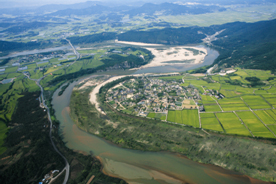
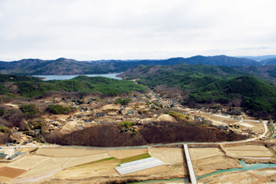
The Epitome of “Koreanness”
In modern times, urbanization and industrialization in Korea have destroyed traditional villages in great numbers. Nonetheless, there exist some villages that have maintained their natural environments and original cultural landscapes for hundreds of years. The Cultural Heritage Administration entitles such places “traditional villages” to preserve their culture and have their values as cultural heritages known to the wider public. Some notable examples include Hahoe Village in Andong, Wanggok Village in Goseong, Seongeup Folk Village in Jeju, Oeam Village in Asan, Nagan Folk Village in Suncheon, and Yangdong Village in Gyeongju. Among them, the villages of Hahoe and Yangdong were inscribed as the UNESCO World Heritage sites in 2010. Founded around the 15th century during the Joseon Dynasty (1392-1910), the two villages have well-preserved traditional architecture surrounded by natural environments that reflect the legacy of Confucian thoughts and principles. Their residents also have maintained the Confucian lifestyle and other cultural traits of the distant past.
Traditional villages of Korea can be classified into two categories. One is the same-clan village, which consists of one or two clans who have been living in the village for generations, exercising substantial control over village affairs. The other is the mixed-clan village, which, as the name implies, is composed of many different clans. In the Joseon Dynasty, it was one of the Confucian ideals for each clan of the noble class called yangban to create its own village in a place with auspicious geomantic properties and scenic beauty. Therefore, many of the yangban families formed a community where the majority of its residents were relatives with the same last name. These communities contributed to having Confucian culture take root in the provinces. Hahoe and Yangdong are elite clan communities, which can be traced back to the noble families of the Joseon Dynasty.
Yangban originally referred to government officials recruited through high-level state examinations, but gradually turned into a hereditary social class. They often worked for the government, but some of them settled down in local communities, devoting themselves to their studies and teaching young students based on Confucian ideology and ethics. Their social status and economic power gave them considerable influence on their communities. High-ranking officials or prominent scholars produced in a noble clan elevated and consolidated the clan’s collective social position. The honored clan would build grandiose residences for clan head families (daejongtaek or pajongtaek) as well as ancestral shrines (sadang), ritual halls (jaesil), buildings for housing monuments of familial virtues (jeongnyeogak), outdoor pavilions (jeongja), study halls (jeongsa), private schools (seodang), and Confucian academies (seowon), which in turn gave the clan still greater influence on the local community.-
Hahoe: A Stroll through Ancient Alleyways, Stone Walls and Courtyards
Along with Yangdong, Hahoe is another elite clan community that produced many prominent figures. The village has maintained the typical Confucian landscape of a clan community, which includes clan head family residences, ancestral shrines, study halls, pavilions, Confucian academies and private schools, surrounded by untainted natural environments.
Although it is not known exactly when Hahoe was first established, the village has been home to the Pungsan Ryu clan ever since the clan’s founder Ryu Jong-hye settled down here in the beginning of
the Joseon Dynasty. Later, the village developed into an elite clan community as it produced many distinguished figures among his descendants, such as Ryu Jung-yeong (1515-1573; pen name Yibam) and his two sons, Ryu Un-ryong (1539-1601; pen name Gyeomam) and Ryu Seong-ryong (1542-1607; pen name Seoae).
Ryu Un-ryong held a series of important posts in the Royal Secretariat, and served as governor of Hwanghae Province. In addition, working as a member of the Royal Lectures, he earned the trust of the king. His younger brother Ryu Seong-ryong was one of the prize pupils of the eminent Confucian scholar Yi Hwang (pen name Toegye), and he spent a large part of his life living and studying in his hometown. He served as prime minister and military chief of staff during the Japanese Invasions of 1592-1598. Ryu Seong-ryong’s memoir of the war titled A Record of Penitence and Warning (Jingbirok), along with the Diary in the Midst of War (Nanjung ilgi) written by Admiral Yi Sun-sin, are valuable works of historical literature providing a detailed explanation of the war.
These influential natives of Hahoe helped change the cultural landscape of the village. Ryu Jung-yeong built Yangjindang (House of Cultivating Truth), the residence of the head family of the Ryu clan. His two sons built a series of study halls - Wonji Jeongsa, Binyeon Jeongsa, Gyeomam Jeongsa, and Ogyeon Jeongsa. As the residence of the head family of the senior line descending from Ryu Seong-ryong, Chunghyodang (House of Loyalty and Filial Piety) was expanded and rebuilt from the house in which his eldest son and eldest grandson had lived. These two residences of clan head families stood as the two main pillars of the community. Besides, there are many buildings designated as cultural properties by the government, including study halls, Confucian academies, and many ancient houses, such as Hwagyeongdang (House of Harmony and Respect, or the North Village Residence), Yeomhaengdang (House of Contemplation and Action, or the South Village Residence), Jakcheon Gotaek (Old House of Jakcheon), Juiljae (Home of Juiljae) and Hadong Gotaek (Old House in East Hahoe).
Hahoe is also home to many ancient books and documents, as well as other cultural relics. Some of them are national cultural properties, including Ryu Seong-ryong’s war memoir mentioned above, A Collection of Treasure Books of the House of Ryu Seong-ryong, A Collection of Treasure Relics of the House of Ryu Seong-ryong, and the masks used in the traditional mask dance handed down in the village. One of the village’s intangible cultural properties, the Hahoe Mask Dance Drama (Hahoe byeolsingut talnori) is the oldest mask dance drama in Korea, and was performed by commoners. On the other hand, Boating under Fireworks (seonyu julbulnori) was a noblemen’s game, in which only members of the Ryu clan were allowed to participate. On the night of the full moon in the seventh lunar month, a long rope attached at intervals with bags of burning charcoal was hung across the Nakdong River between Buyongdae Cliff and the river bank on the other side. On the river, under fireworks shot into the sky, groups of noblemen aboard boats enjoyed poetry writing and drinking alcohol. It was quite a sophisticated leisure activity enjoyed only by rich noblemen in the pristine natural environment.
Hahoe is famous for its natural environments which possess a charming harmony with its cultural landscape rooted in Confucianism. Where the Nakdong River meets Mt. Hwa, which rises 271 meters above sea level, the river changes its course and bends around a low hillock which is the seat of Hahoe, meaning the village “at a river’s bend.” Some liken the village to a lotus blossom floating on the water, and others describe it as resembling a gigantic yin-yang symbol (taegeuk) formed by the mountain and the river.
Buyongdae Cliff commands a sweeping view of Hahoe. Study halls and Confucian academies are scattered around this scenic point with a rugged cliff rising from the river. Viewed from the cliff, the village is bounded by the river on its south, west and north, and the land connected to Mt. Hwa is a field for farming, which is the source of livelihood for the residents of the village.
Hahoe is accessed by a mountain pass to the entrance of the village. The main road that cuts across the cluster of houses leads to an over 600-year-old zelkova tree at the heart of the village, which is said to have been planted by Ryu Jong-hye, the founder of the Ryu clan of Hahoe. The main road branches out in various directions into alleyways that lead to the riverside or to the farming field. In Hahoe, there are 150 households living in 127 houses. Unlike the houses in other traditional villages, which invariably face due south or southeast, houses in Hahoe are not aligned to face a fixed point because each of them was built to overlook the view of the river that almost encircles the village. The main road divides Hahoe into north and south villages. Large residences such as Yangjindang and Hwagyeongdang in the north village and Chunghyodang and Yeomhaengdang in the south village serve as the center of each neighborhood. Smaller houses with tiled or thatched roofs that flock together around the residences were the dwellings of commoners and servants in the Joseon era. At a glance, the houses seem to have been built quite haphazardly, but the entire village stands in excellent harmony with its natural surroundings, creating a picturesque landscape.
Hahoe is a living community which has retained its centuries-old lifestyle based on Confucian philosophy and ethics. The clan organization exercises control over any important decision-making process concerning community affairs. They publish and update the genealogical record of their clan, and conduct a variety of ancestral rites as well as collective village rites to promote unity among the kinship community.-
Yangdong: The Soothing Power of Tradition
When ancient Koreans chose a site for settlement, they considered not only the general conditions of the site itself but also its surroundings, including the natural beauty or the presence of arable land nearby. While Hahoe is a riverside village, Yangdong is nestled on the ridges of Mt. Seolchang (161 meters). Both villages are seated in the midst of breathtaking nature far from large cities. 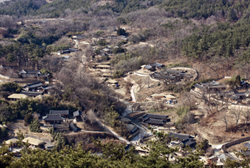
Yangdong began to thrive as the Wolseong Son clan and the Yeogang Yi clan settled down in the village. The Son clan began with Son So (1433-1484; pen name Yangmingong), who moved into this hometown of his wife in the early Joseon period. The Yi clan was founded by Yi Beon (1463-1500; pen name Chanseonggong) as he married the eldest daughter of Son So and had a family here. Yi Beon’s eldest son is the famous Confucian scholar Yi Eon-jeok (1492-1553; pen name Hoejae). Son So had five sons, and the Sons of today’s Yangdong are the head family of the senior line descending from his second son Son Jung-don (1463-1529; pen name Ujae), who served as minister of public works and minister of personnel, among other high-ranking government posts. Yi Eon-jeok, on the other hand, was highly acclaimed as Joseon’s first scholar to have a thorough understanding of Neo-Confucianism expounded by Zhu Xi (1130-1200) of Chinese Song Dynasty. He investigated into the origin of Neo-Confucianism and systematically formulated the doctrine in a series of books. Later, his academic legacy was passed down to Yi Hwang, and further developed by him.Producing such prominent figures as Son So, Son Jung-don and Yi Eon-jeok, Yangdong emerged as an elite clan community in the period between the late 15th and early 16th centuries. What is noteworthy about Yangdong is that its dominant two clans were the descendants on the maternal side of the original natives of the village. However, toward the end of the 17th century, sons-in-law and descendants on the maternal side were denied the right to inheritance and excluded from ancestral rites, and the village turned into a patriarchal clan community. 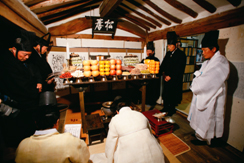
Yangdong is surrounded by Mt. Seolchang, which is located to the north of the city of Gyeongju. Described in terms of geomancy, the four ridges sloping down from the mountain top form the terrain in the shape of the Chinese character 勿, and the houses are nestled on the valleys between the ridges. There are a total of 150 units of tiled-roof and thatched-roof houses including uninhabited ones. While the residences of clan head families and of other noble families are located high on the hill basking in sunshine and commanding a nice view, houses of commoners and servants are spotted on the low-lying ground near the entrance of the village. A vast stretch of the Angang plains unfolds in front of the village. The plains are the source of livelihood for the residents of Yangdong, who make a living by farming. Since the houses are hidden between the ridges, the view of the entire village is not revealed from afar, so its size and configuration is grasped only when one approaches it closely.
Yangdong is also a treasure trove of ancient architecture. There remain as many as four houses built before the Japanese Invasions, which survived the widespread destruction that was caused by the war. The first of the four houses is Hyangdan, which is the house of Yi Eon-jeok, built as the king’s present when he was appointed as the governor of Gyeongsang Province. Concerned about his retainer’s ailing mother, King Jungjong granted the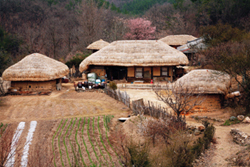
house to Yi, so that he could take care of his mother while living with her there. Secondly, Mucheomdang (meaning the house of “no disgrace to ancestors”) is the clan head family residence of the Yeogang Yi clan. Thirdly, Seobaekdang (meaning the house of “writing the word ‘endurance’ a hundred times”) is the clan head family residence of the Wolseong Son clan. Finally, Gwangajeong is the old house of Son Jung-don. Besides these, there are numerous buildings which have been designated as cultural properties, including Confucian academies, outdoor pavilions and private residences.
At the entrance of the village, the first buildings that come into sight are Gwangajeong and Hyangdan. Each of them seated on a hill opposite of each other, both of the residences command an open view of the Angang plains. At such excellent sites, the head family residences of the two noble clans stand side by side with a small valley between them. For a long time, these two clans have served as the two main pillars of the village, which have worked for the development of their community through competition in good faith. It is a rare case for two different clans to have coexisted in harmony in one village for over 500 years.In Yangdong, there are a large number of ancient trees, as if to symbolize the long history of the village. At the foot of Gwangajeong, there is a ginkgo tree that is over 500 years old, standing guard over the village entrance. The juniper tree in Seobaekdang is also over 500 years old. In addition, there are many old books and documents handed down from the Joseon Dynasty, including the metal type print of Supplement 
to the Comprehensive Mirror for Government (Tonggam sokpyeon) and the Portrait of Son So.In Yangdong,. important life cycle ceremonies, including coming-of-age rituals, weddings, funerals and ancestral rites, have been upheld in a traditional way, and folk games to promote the unity of the village community, such as tug-of-war, have also been preserved until today.
Visiting Korea’s historical villages of Hahoe and Yangdong, one can catch a glimpse of “Korean” sensibilities and landscape, in which nature, geography, scenery, architecture, space, culture and people have interconnected relationships with one another to form a unique community. In the 21st century, whereinthe concept of a village community is lost on most people, they are a valuable cultural heritage suggesting an “old and new” way of making today’s towns and cities into cohesive communities. It is possible to ascertain the precise meaning of the question regarding what it means to be “the most Korean place” if one considers how individual houses form a village and how they relate to nature around them, rather than pay attention to individual structures as an isolated subject of appreciation. 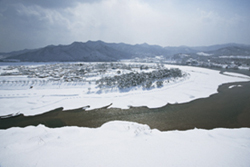



 >
>